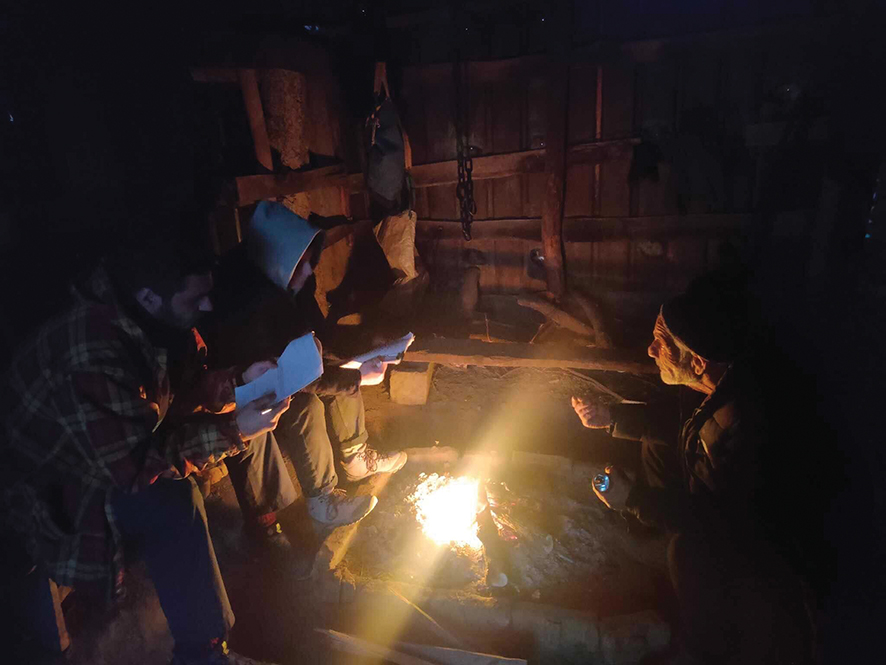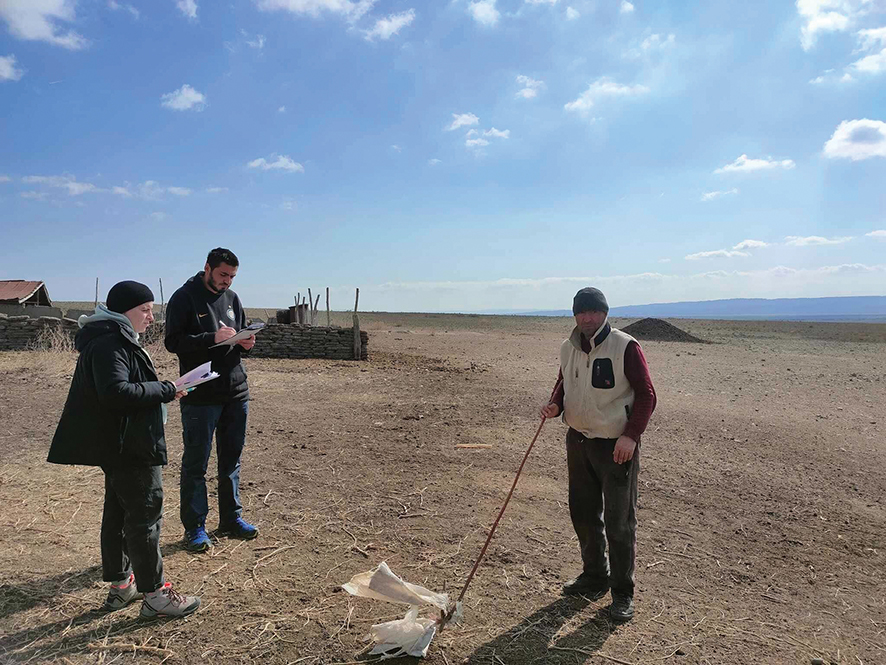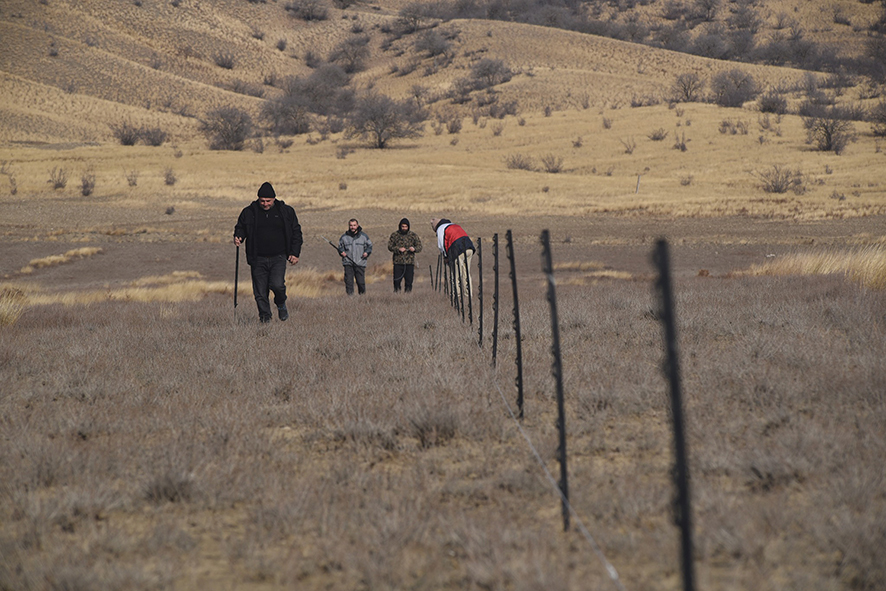In the picturesque region of Kakheti, Georgia, lies a landscape teeming with biodiversity and unique ecological treasures. However, this natural haven faces a significant challenge – the delicate balance between maintaining a living landscape and the looming threat of desertification. Recognizing the urgency of the situation, the Kakheti Steppes project, implemented by BirdLife partner SABUKO, in collaboration with local communities, is diligently working to protect biodiversity and conserve local species.
Building upon the successes of the previously funded “Restoring Gallery Forest and Grasslands in the Iori River Valley” project, the Kakheti Steppes project places a strong emphasis on the restoration of wildlife habitats and fostering collaboration with the pastoralist community. By reviving gallery forests and grasslands, critical habitats for focal species are rejuvenated, supporting their populations and ecological functions. Through thoughtful restoration initiatives, such as reforestation and habitat management, the project aims to preserve the rich biodiversity that thrives in these unique landscapes.
The first stage of the project covered the Chachuna Managed Reserve located in Georgia’s Dedoplistskaro municipality, which has faced a severe problem of degradation due to unregulated grazing, while the second phase covers Chachuna, Kotsakhura Range, Samukhi Valley and Vashlovani Protected Area, covering a territory of 25,000 ha in total.
Prioritizing both ecological and socio-economic wellbeing, a project tackled the revitalization of 25,000 hectares of steppe grassland within the Iori Plateau. Implemented in various stages, this initiative aims to restore land health, promote biodiversity, and empower local communities through sustainable grazing practices.

Various innovative initiatives and methods are being established on the spot to achieve these goals.
Firstly, a robust early warning monitoring system is being established. Through meticulous field studies and data analysis, this system will serve as a vigilant guardian, identifying and mapping areas susceptible to degradation before irreversible damage can occur. This system will be used for different stakeholders before giving land for a lease.

Next, innovative rotational grazing schemes were developed and implemented across the project area. This strategic approach ensures each pasture receives adequate rest periods, fostering biodiversity and preventing overgrazing. Additionally, extensive efforts were undertaken to ensure the active participation and knowledge transfer to local farmers, transforming them into active stewards of the land.

Heavily degraded areas received targeted restoration measures. Cutting grasses, strategically spreading manure, and employing the technique of mob grazing aimed to stimulate plant growth and accelerate recovery. Also, e-fences have been installed. The impact of these interventions was meticulously monitored, providing valuable insights into the effectiveness of restoration strategies.
To guarantee adherence to grazing agreements and ensure responsible land use, a dedicated patrol system was implemented. This system effectively monitored compliance and addressed any emerging challenges, solidifying a framework for long-term sustainability.
For more detailed information, GEORGIA TODAY spoke to SABUKO representatives and regional coordinators, who are directly involved in a daily work on the spot, implementing those important measures in practice.
“When you want the best results, it’s not enough to follow the beaten track and it’s time to experiment,” they note.
Giorgi Chikorashvili, Natural Resource Manager at SABUKO, told us that natural grasslands are vital to local biodiversity, and their damage directly affects the species and their populations, the protection of which is the first and foremost aim of SABUKO.

“For that, we’ve implemented various combined measures,” Giorgi told us, “We decided to install electric fences in the protected area of Chachuna, the protected area of Vashlovani and the multi-use areas of Samukhi. The process is still ongoing. Using electric fences is an eco-friendly and relatively new method in Georgia, which organically fits with the natural environment and is convenient, cheap and “mobile” to use, compared to traditional wire fence. Prior to SABUKO, almost no one in the Georgian market used electric fences, so we ourselves had very little information about its use and benefits, but as a result of research and learning from international experience, we became ‘pioneers’ in this field.
“Initially, we will place a flock of sheep within the fenced area, which will damage the soil by grazing and trampling. Then we will empty the fenced area and, together with scientists and farmers, we will start working on its restoration using different methods.
“When we understand which method or combination of methods contributes to quick and effective soil restoration, we will transfer this strategy to the degraded soils of Chachuna protected area, Vashlovani protected area and Samukhi multi-use area.
“These areas have been used as winter pastures for ages, but due to the excessive number of sheep, the ecosystem loses its ability to self-restore, which leads to soil erosion. That’s why quick action is now necessary to stop this process and save the unique biodiversity.
“As a result of the measures implemented by SABUKO, the situation in terms of pastures restoration and protecting local unique species has been noticeably improved. Currently, we’re carrying out a socio-economic survey to learn how the introduction of rotational grazing affected local farmers economically, how beneficial it is for them financially, what their needs are, and their opinion about the introduction of rotational grazing. SABUKO also conducted the same type of research last year among 82 farmers, but now we’re monitoring the recent progress in this direction. We’re studying the socio-economic considerations related to the development of a sustainable value chain. Also, we want to find out the current condition of lease agreements. Subleasing – a lease by the lessee of a pasture to a third person – is a big challenge for us, as it increases the damage and degradation to the pastures due to a larger number of a sheep. Soon, we’ll have the survey results and start analyzing them.
“Constant monitoring of practical implementation of measures, their effectiveness and law enforcement is also an important part of SABUKO activities on the ground. Sometimes, the law on pastures management is not enforced in practice, which leads to uncontrolled grazing and soil degradation. We’re monitoring the situation through various measures, such as by installing mini GPS on sheep to track their route of movement, and seeing how the farmers enforce and follow our recommendations in terms of sustainable grazing.
“As for analyzing the results of rotational grazing in terms of pastures restoration, when it comes to the natural resources and its recovery, this is generally a long-term process and we’re still learning it scientifically. This is a difficult and long process.
“Communication with farmers on an individual level is also of utmost importance. As a result of awareness-raising activities and informational campaigns carried out by SABUKO, now local farmers collaborate with us in terms of enforcing rotational grazing and care more about lands and natural resources restoration. They even help us monitor the situation on the ground, which makes us happy and proud to see results of our intense work.”

Giorgi Khubashvili, a regional coordinator of SABUKO, elaborated on the visible results of installing fences and other measures implemented on the ground.
“If we compare the situation outside and inside the fence, what trees and plants are growing, the result and the difference is striking. Inside the fence, the ground is green, grass grows, and outside, where the sheep move, it is almost no grass,” he tells us.
“Also, an early warning system was installed in the risk zones. We communicate with each farmer on an individual level and warn them not to bring sheep and cattle there. Also, we have installed warning banners indicating that grazing is not allowed in that area.
“As it is now winter, the sheep have less feed and farmers have to pay extra to buy feed for them. Our goal is to achieve the result that, in addition to saving biodiversity and growing more grass on the site, they will eventually not have to pay additional costs. The grass coming to their territory will be quite enough to feed their sheep in winter without buying additional feed.
“Once we see the results of the pilot program, both we and the shepherds, already taking into account their consent and great desire, will jointly carry out these measures and gradually introduce rotational grazing on the entire 25,000 hectares.
“Raising the shepherds’ awareness about the importance of rotational grazing and the conservation of natural resources in general has been achieved through individual, intensive communication with them by the SABUKO team, which is great to see. Now we try together to take care of the environment, because they already understand better that it will be beneficial for them. We visit their farms often, explain the essence of this program, talk about the importance of rotational grazing and sustainable pasture management, which obviously increases their trust and awareness of the issue. As a result of our communication, they are more careful about the environment. They try not to have more sheep than is allowed for the area.
“It is also important to introduce a patrolling system so that the achieved results can be maintained and constantly monitored. The winter season is especially difficult and time-consuming in this regard, because many new shepherds are needed during this period, and many of them may not know how to behave and how to graze sheep in a way that takes care of natural resources and the environment. That is why our team is in constant contact with them and actively monitors them. We warn everyone and explain how they should behave.”
Another regional coordinator of SABUKO, Rezi Kvaratskhelia, told us that the results of the organization’s activities are still being studied, as it takes time to see the difference, however, he noted, the achieved progress and results are promising.
“We work constantly with farmers, conduct interviews with them to learn more about their needs, we try to improve their well-being along with restoring natural resources. Fortunately, they see and appreciate it. Installing electric fences on the ground at their request is also proof that our pilot project has been justified, timely and successful. We, the SABUKO team, continue to work actively and spare no effort to preserve the unique local biodiversity, which is crucial work and valuable thing for Georgia’s biodiversity, for generations to come,” he explained.
Recognizing the crucial role of education in empowering future generations, a specialized range land management course was established at Ilia State University. This academic offering equips students with the necessary knowledge and skills to become champions for sustainable land management practices, ensuring the continued success of the project’s goals beyond its immediate timeframe.
By prioritizing ecological restoration, engaging local communities, and fostering long-term knowledge transfer, the initiative has paved the way for a flourishing future for the Iori Plateau, its diverse ecosystems, and its inhabitants.
By Ana Dumbadze














